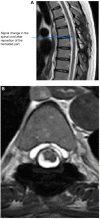Idiopathic ventral spinal cord herniation: an increasingly recognized cause of thoracic myelopathy
- PMID: 25336997
- PMCID: PMC4196882
- DOI: 10.4137/JCNSD.S16180
Idiopathic ventral spinal cord herniation: an increasingly recognized cause of thoracic myelopathy
Abstract
Idiopathic spinal cord herniation (ISCH), where a segment of the spinal cord has herniated through a ventral defect in the dura, is a rarely encountered cause of thoracic myelopathy. The purpose of our study was to increase the clinical awareness of this condition by presenting our experience with seven consecutive cases treated in our department since 2005. All the patients developed pronounced spastic paraparesis or Brown-Séquard syndrome for several years (mean, 4.7 years) prior to diagnosis. MRI was consistent with a transdural spinal cord herniation in the mid-thoracic region in all the cases. The patients underwent surgical reduction of the herniated spinal cord and closure of the dural defect using an artificial dural patch. At follow-up, three patients experienced considerable clinical improvement, one had slight improvement, one had transient improvement, and two were unchanged. Two of the four patients with sphincter dysfunction regained sphincter control. MRI showed realignment of the spinal cord in all the patients. ISCH is probably a more common cause of thoracic myelopathy than previously recognized. The patients usually develop progressive myelopathy for several years before the correct diagnosis is made. Early diagnosis is important in order to treat the patients before the myelopathy has become advanced.
Keywords: dural defect; magnetic resonance imaging; medullary herniation; spinal cord; thoracic myelopathy.
Figures





Similar articles
-
Idiopathic spinal cord herniation at two separate zones of the thoracic spine: the first reported case and literature review.Spine J. 2011 Aug;11(8):e9-e14. doi: 10.1016/j.spinee.2011.07.003. Epub 2011 Sep 8. Spine J. 2011. PMID: 21862417 Review.
-
Spinal cord herniation repair with microstaples: case report.J Neurosurg Spine. 2017 Mar;26(3):384-387. doi: 10.3171/2016.8.SPINE16318. Epub 2016 Nov 4. J Neurosurg Spine. 2017. PMID: 27813449
-
Novel Strategy of Ventral Dural Repair for Idiopathic Thoracic Spinal Cord Herniation: Report of Outcomes and Review of Techniques.Oper Neurosurg. 2019 Jul 1;17(1):21-31. doi: 10.1093/ons/opy244. Oper Neurosurg. 2019. PMID: 30517700
-
Ventral transdural herniation of the thoracic spinal cord: surgical treatment in four cases and review of literature.Acta Neurochir (Wien). 1999;141(9):907-13. doi: 10.1007/s007010050396. Acta Neurochir (Wien). 1999. PMID: 10526071 Review.
-
Idiopathic spinal cord herniation: case report and review of the literature.J Spinal Cord Med. 2009;32(1):86-94. doi: 10.1080/10790268.2009.11760757. J Spinal Cord Med. 2009. PMID: 19264054 Free PMC article. Review.
Cited by
-
Posterior Surgical Approach for Ventral Cervical Spinal Cord Herniation: 2-Dimensional Operative Video.Oper Neurosurg. 2021 Feb 16;20(3):E215-E216. doi: 10.1093/ons/opaa340. Oper Neurosurg. 2021. PMID: 33372993 Free PMC article.
-
The Pathogenesis of Ventral Idiopathic Herniation of the Spinal Cord: A Hypothesis Based on the Review of the Literature.Front Neurol. 2017 Sep 11;8:476. doi: 10.3389/fneur.2017.00476. eCollection 2017. Front Neurol. 2017. PMID: 28955299 Free PMC article.
-
A successful surgical management of spinal cord herniation in a patient with old thoracic spine fracture: a case report from Syria.Int J Surg Case Rep. 2025 Jun;131:111394. doi: 10.1016/j.ijscr.2025.111394. Epub 2025 Apr 29. Int J Surg Case Rep. 2025. PMID: 40306102 Free PMC article.
-
Single-centre study comparing surgically and conservatively treated patients with spinal cord herniation and review of the literature.Brain Spine. 2021 Oct 23;1:100305. doi: 10.1016/j.bas.2021.100305. eCollection 2021. Brain Spine. 2021. PMID: 36247388 Free PMC article.
-
Double trouble!!! An unusual presentation of cervical cord herniation and medial end clavicle non-union in a single patient.BMJ Case Rep. 2018 Apr 18;2018:bcr2018224393. doi: 10.1136/bcr-2018-224393. BMJ Case Rep. 2018. PMID: 29669773 Free PMC article.
References
-
- Wortzman G, Tasker RR, Rewcastle NB, Richardson JC, Pearson FG. Spontaneous incarcerated herniation of the spinal cord into a vertebral body: a unique cause of paraplegia. Case report. J Neurosurg. 1974;41(5):631–5. - PubMed
-
- Novak K, Widhalm G, de Camargo AB, et al. The value of intraoperative motor evoked potential monitoring during surgical intervention for thoracic idiopathic spinal cord herniation. J Neurosurg Spine. 2012;16(2):114–26. - PubMed
-
- Hassler W, Al-Kahlout E, Schick U. Spontaneous herniation of the spinal cord: operative technique and follow-up in 10 cases. J Neurosurg Spine. 2008;9(5):438–43. - PubMed
-
- Massicotte EM, Montanera W, Ross Fleming JF, et al. Idiopathic spinal cord herniation: report of eight cases and review of the literature. Spine. 2002;27(9):233–41. - PubMed
LinkOut - more resources
Full Text Sources
Other Literature Sources

